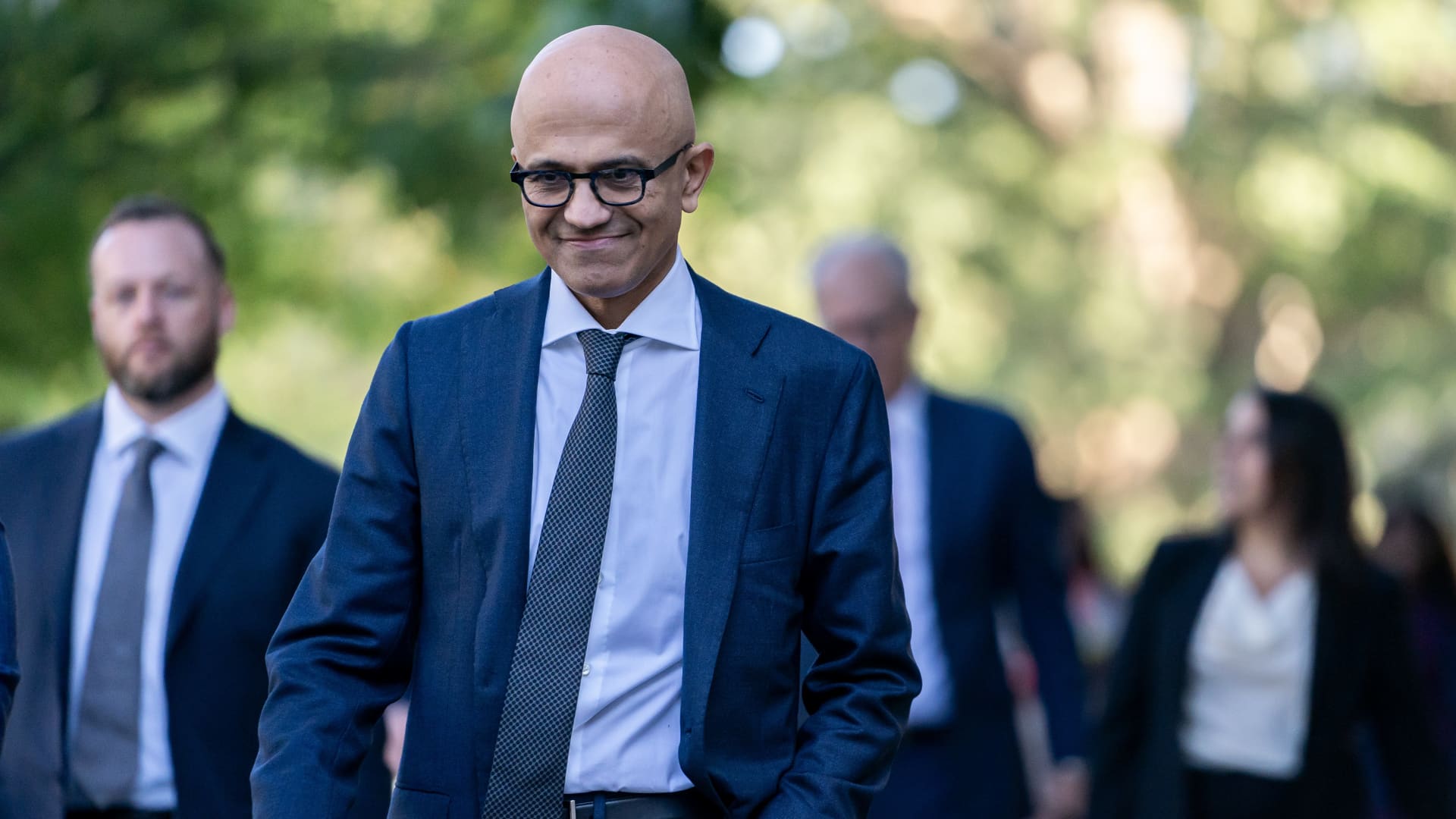Here’s how the company did, compared with the consensus among analysts surveyed by LSEG, formerly known as Refinitiv:
Earnings per share: $2.99 vs. $2.65 expectedRevenue: $56.52 billion vs. $54.50 billion expected
With respect to guidance, Amy Hood, Microsoft’s finance chief, called for fiscal second-quarter revenue in the range of $60.4 billion to $61.4 billion on a conference call with analysts. That implies 15% growth. Analysts polled by Refinitiv had expected $60.9 billion in revenue.
Revenue grew almost 13% year over year in the quarter from $50.12 billion in the year-ago quarter, according to a statement. Net income, at $22.29 billion, increased 27% from $17.56 billion, or $2.35 per share, in the same quarter a year ago.
Microsoft’s Intelligent Cloud segment produced $24.26 billion in revenue, up 19% and above the $23.49 billion consensus among analysts surveyed by StreetAccount. The unit comprises the Azure public cloud, SQL Server, Windows Server, Visual Studio, Nuance, GitHub and enterprise services.
Revenue just from Azure jumped 29% during the quarter, higher than the 26% consensus among analysts that CNBC and StreetAccount polled. Microsoft doesn’t disclose Azure revenue in dollars. At constant currency, Azure revenue rose 28%, accelerating from 27% in the fiscal fourth quarter.
For the second half of the 2024 fiscal year, Hood said to expect Azure growth at constant currency to remain stable compared with the fiscal second quarter, which should come in at 26% to 27%.
Microsoft is “still helping customers use the Microsoft Cloud to get the most value out of their digital spend, and driving operating leverage,” CEO Satya Nadella said in the earnings release. Hood said clients are still finding ways to save money on cloud spending, a trend multiple large cloud infrastructure providers have flagged in the past few quarters.
“We’ll lap some of those cycles that were fairly extreme perhaps in the second half” of the fiscal year, Nadella said.
Meanwhile, clients are flocking to new generative artificial intelligence tools in the cloud that are enhanced with software from Microsoft-backed startup OpenAI. The Azure OpenAI Service now has 18,000 customers, up from 11,000 customers in July. Higher capacity for graphics processing units in Azure boosted growth, Hood said.
Around 3 percentage points of the quarter’s Azure growth was tied to AI, Hood said. Three months ago, the company had forecast 2 points of Azure growth in that area.
“Looking on a competitive basis, we feel good about our execution, we feel good about taking share and we feel good about consistent trends,” Hood said.
The Productivity and Business Processes unit posted $18.59 billion in revenue, which was up 13% and more than StreetAccount’s $18.19 billion consensus. The unit contains Microsoft 365 productivity app subscriptions, LinkedIn and Dynamics enterprise software. The Teams communication app now has more than 320 million monthly active users, up from 300 million six months ago, Nadella said on a conference call with analysts.
Hood was cautious when talking about the potential revenue lift from the introduction of the Microsoft 365 Copilot AI add-on for existing productivity software subscriptions, which will become available to large companies Nov. 1, starting at $30 per person per month. She said the company expects “related revenue to grow gradually over time.”
Microsoft’s More Personal Computing segment featuring Windows, Xbox, Bing and Surface contributed $13.67 billion in revenue. That was up 3% and higher than the $12.85 billion StreetAccount consensus.
The company reported 4% growth in sales of Windows operating-system licenses to device makers, ending a streak of five quarters of year-over-year declines. The PC market has started to stabilize, Hood said. Shipments were down 9% in the third quarter, compared to a 30% decline in the first quarter, according to estimates from technology industry researcher Gartner.
Microsoft continued to slow its growth in research and development and sales and marketing costs. Operating expenses increased 1.3%, the slowest rate since 2016.
During the quarter, Microsoft introduced fresh cybersecurity services, announced new Surface PCs and said it would sell its Microsoft 365 Copilot AI add-on to enterprises starting Nov. 1.
Earlier this month, Microsoft completed its $68.7 billion acquisition of video game publisher Activision Blizzard. While Activision isn’t incorporated into Microsoft’s fiscal first-quarter results, it will partly affect earnings for the next quarter, so executives will likely discuss it when providing guidance.
Notwithstanding the after-hours move, Microsoft stock is up 38% so far this year, while the S&P 500 index is up about 11% during the same period.
WATCH: The tailwinds of AI are starting to kick in for Microsoft, says Jefferies Brent Thill
Don’t miss these CNBC PRO stories:
Want to retire in 5 years? Here’s how to invest for it, according to the prosMorgan Stanley says the average stock is breaking down, S&P 500 to fall to 3,900 by year-endThis highly profitable industry is booming as the population agesThis chip stock is getting a ton of love from Wall Street, and it’s not Nvidia


